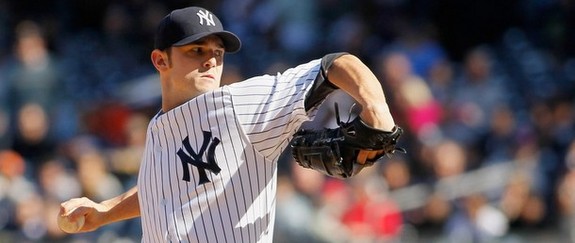
This offseason, David Robertson agreed to a deal that brings him to the south side of Chicago — he will wear different pinstripes starting next season. I’m still not too familiar with the concept of other teams signing away the Yankees’ homegrown players (even after the Robinson Cano fiasco last winter) so it isn’t easy envisioning Robertson in a different uniform even though the White Sox also feature a pinstriped design. Well, we may never see D-Rob pitch in the Yankee pinstripes anymore, but we do have memories of his dominance in the recent past.
If you’ve been following the Yankees since prior to the 2008 season, you may remember when he first came up — I remember seeing Robertson as a young reliever with great MiLB numbers but his velocity back then wasn’t too impressive (averaged 90.8 mph in 2008) and also gave up his share of walks (4.45 BB/9). In 2009, however, while he allowed walks more frequently (4.74 BB/9), his average velocity saw a bump to 91.8 mph and he struck out more hitters (12.98 K/9). He followed it up with a decent 2010 (3.58 FIP in 61.1 IP) and then … 2011 happened.
First off, this may not seem believable now, but Robertson started the season as the third setup option behind Rafael Soriano and Joba Chamberlain. Soriano, who had signed a lucrative deal just to set up Mariano Rivera (and to possibly be his replacement after retirement), missed a good chunk of the season with an injury and Joba hurt his elbow in June, requiring Tommy John surgery. Fortunately for the Bombers, at the time of Joba’s injury, Robertson was in a middle of a phenomenal season: 1.16 ERA in 23.1 IP with 38 K’s — that ERA is impressive considering he also had allowed 18 walks for a 6.94 BB/9.
From then on, after taking over as the eighth-inning guy, Robertson just took off: 1.04 ERA in 43.1 IP with 62 K’s and 17 walks. That’s 12.88 K/9 and a much-improved 3.53 BB/9 during that time span. He would continue to lower his walk rate in the next seasons (2.82, 2.44 and 3.22 after 2011)
A lot of you may remember that it seemed like every time D-Rob was out there, he allowed one or two baserunners to reach yet escaped unscathed in the end. At times, he got into dicier situations yet protected the Yankees’ lead with his uncanny ability to strike hitters out. It was also in 2011 that Robertson got his nickname “Houdini” for his magic-like ability to get out of jams. According to ESPN New York’s article from May 2011, Joba coined the nickname for D-Rob after the righty got out of a one-out jam with the runners on the corners against the Mets. (Robertson struck out Carlos Beltran and got Jason Bay to pop out).
Digging more into the stats, in FanGraphs classified “high leverage situations,” Robertson allowed only 7 hits versus 78 batters faced and only 2 extra base hits (no homers) in 2011 — good for .106/.244/.152 slash line. He also struck out nearly half of them with 35 punchouts for a 44.9% rate. Anything else? In “high leverage situations,” the reliever only allowed 6.5% line drives in batted balls as opposed to 21.6% overall. Also, not to mention 89.8% runners left on base rate, quite high considering the league average rate is around 70-72%. Well, quite simply, Robertson was the guy you wanted in late in the games to protect the lead for Rivera to save it, and that’s what Joe Girardi and the Yanks exactly did.
If I had to choose one “Houdini act” from 2011 that linger in memories, I would point to the eighth inning of the September 13 match versus the Seattle Mariners. Well, just so you know that it’s from the 2011 season, I’d like to inform you that A.J. Burnett started the game for Yanks and on the other side, it was Charlie Furbush.
Bottom of the 8th, with the Yankees leading 3-2, New York had 72% chance of winning the game. The 2011 Mariners were not exactly an offensive powerhouse, but Robertson came into the game slated to face the 3-4-5 hitters (Dustin Ackley, Mike Carp, Justin Smoak). D-Rob allowed a base hit to Ackley but struck out Carp for one out. But after a 7-pitch battle, the righty walked Smoak. With runners on 1st and 2nd with one out, the Yankees’ odds of winning dropped to 62%. Next up … Miguel Olivo. Robertson went on to strike out the catcher after going to a full-count but Ackley and Smoak also stole the 2nd and 3rd base. New York then intentionally walked Adam Kennedy — I repeat, Adam Kennedy, who, at the time, was hitting for a .628 OPS. After that, the chances of a Yankee win was at 65%.
That brought up a pinch-hitter, Trayvon Robinson. Fortunately for the Yankees, Robinson was very prone to strikeouts. He was one of those AAAA-type guys that had good speed and athleticism (and once showed promise with the bat) but never panned out in the Major Leagues. With the Mariners that year, Robinson struck out 39.4% of the time in 155 PA, which is not good — but good for D-Rob. The righty struck out Robinson in 5 pitches and got out of the jam. The odds of the Yankee win rose from 65% to 85%. Here’s the video:
For me, having D-Rob in the game didn’t mean that everyone was an automatic out — instead, him entering the game was pretty much an automatic hold. He put the game into a more interesting yet nerve-wrecking situations by getting into jams, but he somehow managed to get out of them. Perhaps that’s why I remember his 2011 so fondly — he wasn’t perfect but damn, it was fun to be on the edge every time he pitched.
Leave a Reply
You must be logged in to post a comment.